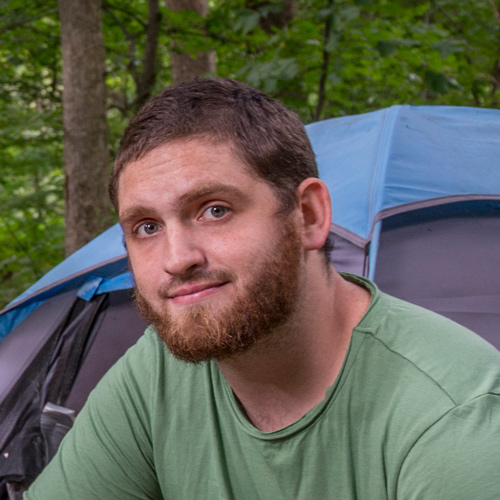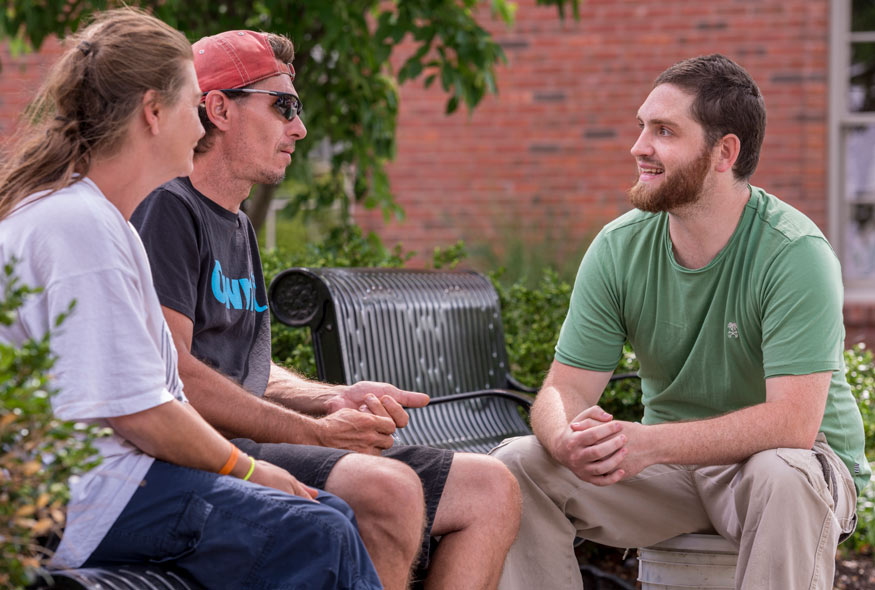
Feet on the Street
Mark Ruf trudges into the woods, moving his shoulders horizontally to slide through the brush. When the path opens a bit, Ruf knows that means this area is being used as a camp by people experiencing homelessness. He’s right — after a few hundred yards, he finds a tent.
In the distance, Ruf can see the remnants of a camp he’s helped clear, where people have moved into housing after living in the woods. Ruf is familiar with these settings as an outreach worker at RHD’s Street2Feet Outreach Center. But this summer Ruf took his job a step further, as Street2Feet partnered with the county in a project that had Ruf living on the streets for a week to find out firsthand what gaps exist in local services and how to fill those gaps.
Ruf surrendered his wallet and credit cards, received only a few dollars a day to live on (the daily average of a typical monthly food stamp payment). He slept in tents, camping out in a car one night, and became intimately familiar with camps like this one, surrounded by refuse and waste.
“To a lot of people, this is what homelessness looks like in Stroudsburg,” Ruf said. “But it doesn’t have to be this way.”
Street2Feet, located in Stroudsburg, a borough in Monroe County, Pennsylvania, provides vital services to people experiencing homelessness, including case management; linkage to mental health services; linkage to Drug & Alcohol services; medical clinic; dental clinic; and vocational support. In a year, Street2Feet will receive more than 5,000 total visits from more than 400 clients, according to monthly data compiled at the outreach center. Since opening its doors last year, Street2Feet helped house 80 people, and helped 50 people find jobs.
Street2Feet is part of RHD’s Crossroads Community Services, a permanent supportive housing program providing services to people who have serious and persistent mental illness, and who have experienced homelessness. Intensive case management provides recovery-oriented services and helps people sustain their housing.
“The unique challenge in Monroe County, because it’s close to New York City and New Jersey, and because of the proximity to the university, is that you see higher rents and very limited affordable housing given a pretty large population,” said Leslie Perryman, director of Crossroads Community Services and Street2Feet. “There is a larger homeless population than there are supports around them. We’ve seen a large population become homeless even though they’re working because they can’t sustain housing, plus people who are struggling to find employment when local industry closed down. Our 2013 point-in-time count showed 133 people living unsheltered, a number that rose to 183 in 2015 — and that’s a huge number for this area.”
There are fewer than 90 beds available for more than 180 people experiencing homelessness, in a county where 15 percent of residents live below the poverty line. The need was met in part by a grant that set up funding for Crossroads and Street2Feet. In addition to helping people get health insurance and other benefits, an average of five people each month are able to attain housing with the support of these RHD programs.
Even with that progress, Ruf took on his project to see where services could be improved.
“If we can figure out a way to do one thing better for our clients, it’s worth sleeping outside for six days,” Ruf said.
“You spend a lot of time trying to get food in your stomach and looking for a safe place to sleep,” Ruf said. “One of the things we learned is that there is no meal on Saturday that is conveniently located for our population; we have people we’re trying to support who are not eating for 24 hours. So we’re investing in MREs, military ready-to-eat meals. Add water, they’re self-heating, self-contained, they’re not going to expire, they’re ready to go.
“Street2Feet doesn’t do meals; we’re diving into Saturday meals because we see there’s a need that wasn’t being met elsewhere. That’s something that was cool to see, how we fit into that puzzle. We want to make sure we’re not duplicating services, which just enables the population and isn’t efficient.”
He also discovered how important shoes are.
“Our clients already ask for shoes, and you can see why — you have to walk a lot,” Ruf said. “Three days in, I had blisters. I know how to treat blisters, but a lot of the homeless population doesn’t. Their feet get infected and if you can’t walk, you can’t eat.”
The project received heavy coverage in the local media, to the point where Ruf had this experience: “On day one, I was behind a grocery store getting my stuff from under a bush where I’d hidden things, and I was behind a business, and the owner came out and said: Hey, are you that guy?”
“PR was the best thing that came out of it,” Ruf said. “One of the goals going in was to engage new people and bring new clients into our program, but during the project I learned that our clients are great at advocating for us. That was a learning experience, and a huge upside — seeing how good our word of mouth is with our clients. I’m in the community some of the time, they’re in that community all the time. I was able to stop being worried about getting more people to come through our doors.
“But we got such positive feedback, it had such scope. We really see it in community engagement with our work here, particularly people donating items that our population needs, from shoes to shampoo. We are not ones to brag about ourselves; we aren’t here to say: Look at me! But sometimes in order to get the resources our clients need, sometimes you need to say: Hey, look at us. Look at what our clients did, look at what our clients are experiencing.”

In the west end of Monroe County and in Mt. Pocono, where resources for people experiencing homelessness often verge on non-existent, the awareness raised by Ruf’s project inspired a homelessness summit. Street2Feet will help lead a discussion where churches, community groups and other providers will gather to explore new ways to meet the needs Ruf’s project detailed.
“What I learned is that Stroudsburg is doable; the west end and Mt. Pocono aren’t doable,” Ruf said. “You’re going to see a transient population out there because you don’t see the resources. Now, that’s actually good; that makes sense. You don’t want the county trying to have three diff hubs where homeless people experience services, you want one hub — and it makes sense for Stroudsburg to be the hub.”
When Ruf recently re-walked some of the areas he’d frequented while living homeless, he came upon George’s old camp in the woods. George had been living in a tent in a homeless camp for three years when Ruf first made contact. After many visits to gain his trust, George eventually came to the center, where he received support in locating a housing program that suited his needs. George has maintained his housing almost a full year and is currently receiving the medical treatment he needs. The camp where he’d lived for so long is now abandoned.
“That’s what we want,” he said. “We love to kill these camps.”


